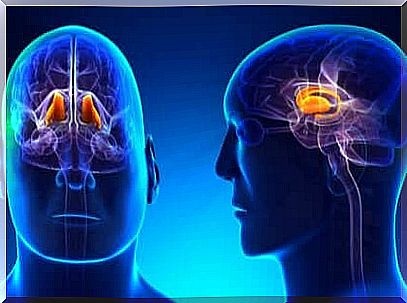How Does The Body Perceive Pain And Temperature?

Have you ever wondered why we can feel pain? Or how do we know if it’s hot or cold? How do people acquire this ability that is so important to our survival? In this article we talk about the somatosensory system, which is responsible not only for feeling pain and temperature, but also for proprioception. This is the body’s awareness of position, posture, movement, etc.
The somatosensory system is one of the largest systems in the body. It processes sensory information (that is, pain and temperature ) from some receptors in the body and skin. Its receptors are distributed throughout the body. There are two types of somatosensory systems:
- Somatosensory system of the skin. Receptors in the skin make up this system, which is peripheral. It has kinesthetic receptors that take in information related to body position and movement. The receptors are located near the joints and tendons.
- Organic somatosensory system. This system has receptors in bones, muscles and intestines. It’s an internal system.

The Skin Somatosensory System: The Key To Understanding The Perception Of Pain And Temperature
If you want to understand how people perceive pain and temperature, you first need to understand how the skin’s sensory receptors work. Because the most sensitive sensory receptors are located on the skin and can produce pain sensations.
The skin is the largest organ in the body. As a result, it is also the largest sensory receptor. There are many sensory receptors that are distributed in different ways throughout the body. They determine the sensitivity to stimuli and all four sensations that you perceive through the skin: pressure, vibration (touch), pain and temperature.
Pain and temperature: is body hair relevant in this regard?
There is a difference between hairy skin and the areas of skin that do not have hair. Most of the skin on our body is covered with hair. However, the areas of the skin that are hairless actually contain many more receptors than the hairy skin, making it more sensitive.
The most sensitive sense organs are the lips, the external genitals and the fingertips. These parts of the body have the highest density of sensory receptors.
While no definitive studies prove this to be the case, scientists believe that hairy skin is more sensitive to vibration and touch. Because both sensations set the hair in motion.
Which sensory receptors are found in the skin?
Skin receptors are divided into two categories: free nerve endings and encapsulated nerve endings.
Free nerve endings (FNEs) are nerve fibers that end on the skin. They’re probably the simplest sensory receptors out there. They are all over the skin and are most sensitive to the perception of pain. While they can perceive other sensations as well, their specialty is pain perception.
The transduction mechanism of FNEs occurs when a certain part of the FNEs expands, which allows the sodium channels to open. This in turn leads to a depolarization of the membrane, which creates an action potential. Contraction can cause transduction in cold temperatures and dilation in hot temperatures.
Encapsulated receptors
Encapsulated receptors are a type of sensory skin receptors. Your name is self explanatory; they are called encapsulated receptors because they are covered by a capsule. Some scientists divide them into four types, others into five. They classify the receptors as follows:
Pacinian corpuscles: Sensitive to pressure and touch
These receptors are mostly found in hairless skin, although they are also found in skin with hair. They are densely arranged in the lips, mammary glands, and external genitals. Pacinian corpuscles are particularly sensitive to pressure and vibration and less sensitive to pain and temperature.
Ruffini corpuscles
These are small, encapsulated receptors. Their nerve endings are similar to FNEs, except that they are surrounded by connective tissue. They are found in hairy skin and react to low-frequency vibrations.
Meissner corpuscles
These receptors are supposed to perceive a gentle touch. They occur in hairless skin, which is specifically located in the dermal papillae.
Krause end piston
Krause end flasks occur exclusively at the intersection of the mucous membrane and dry skin. Its fibers are not myelinated and extremely sensitive to pressure. They have the lowest pressure threshold in the entire body.
Merkel discs
Merkel discs are also located in the dermal papillae. They are receptors that slowly adapt. Also, they only respond to a continued change in the stimulus, such as B. a change in temperature.
How does the body perceive pain and temperature? – The sensation of pain
The body has an adaptive alarm system that enables the perception of pain and temperature. This helps us avoid things that could cause us harm, although emotional, psychological, and social factors also affect the sensations of pain. In addition, things like medication, placebos, and hypnosis can also affect pain perception.
Consequently, pain is a very subjective emotion. This suggests that there must be neural mechanisms that modify or disrupt the transmission of pain, and that they do not depend solely on the skin’s sensory receptors.
There are two types of pain:
- Avoidable pain. The best answer is to withdraw from the source of the pain.
- Inevitable pain exists at the peripheral and central levels. As the name suggests, it is the kind of pain that cannot be removed.
When pain is unavoidable, scientists find that there is molecular information about the pain. When you feel pain, the damaged cells release histamine and prostaglandin. Histamine lowers the cell’s pain threshold. Prostaglandin makes the damaged cells more sensitive to histamine, which only affects the pain threshold even more.
This type of pain affects damaged tissue. There are drugs that block histamine (antihistamines) and prostaglandin (acetylsalicylic acid, also known as aspirin).
Can we ward off pain?
Studies point to the thalamus when it comes to centralized pain. Although the pain is adaptable, if it is very intense it can affect behavior. This can be counterproductive and some people wonder if it is possible to avoid pain completely. So is there any way we can block the thalamus?
We usually call pain suppression analgesia. Emotional and physiological factors influence this process. However, some stroke patients note that their injury or blockage of the anterior posterior core of the thalamus tends to be associated with loss of skin feel. In other words, they lose superficial sensations such as touch and pain.
Similarly, injuries to the intralaminar nuclei block deep pain. On the other hand, however, they do not affect the feel of the skin. Dorsomedial nuclei are related to the limbic system and tend to interfere with the emotional components of pain.

How does the body perceive pain and temperature? – The temperature perception
Temperature perception is relative, as humans do not have sensory receptors that provide absolute information about temperature. We can therefore only perceive sudden changes in temperature. For example, when we move our hands from very cold water to very hot water.
There are two types of receptors here too, one for cold and one for heat. They are distributed heterogeneously over the entire skin. Cold receptors are closer to the epidermis, while heat receptors are in a deeper zone. They are the same type of receptors. The only difference is their location.
The deformation of the membrane or receptor cone, due to stretching or contraction of the skin, is the cause of transduction. This deformation opens the membrane and the sodium channels. When the receptors are too close together, we feel the heat more intensely. The nuclei in the thalamus that make it difficult to sense cold or heat are the intralaminar nuclei and the ventricular nuclei.
It is therefore interesting to note that the sensation of pain and the perception of temperature are due to small receptors in the skin and the involvement of the thalamus.
In summary, all of these functions seem to have evolved to ensure human survival.









